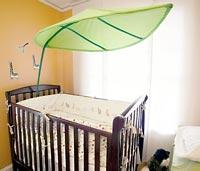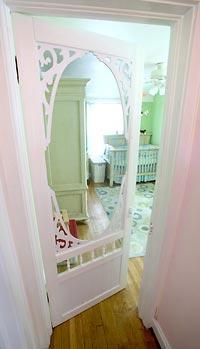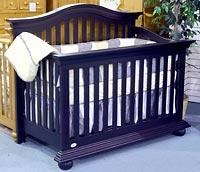Nursery furnishings with growth potential

Baby furniture is growing up fast.
Gone are the days of cute, white-painted cribs that barely make it into toddlerhood. New nursery furnishings are more sophisticated and can mature with a child from cradle to college and beyond.
Stores are selling an increasing number of cribs that become toddler beds and even full-size beds using conversion kits and different mattresses.
Nursery furniture is also changing in looks. Expectant parents of the high-tech generation are going for more modern, streamlined pieces that fit in with the rest of their décor.
Also, they are investing in pieces that can transition into other rooms. (A nice armoire can be used in the nursery and the living room.) And they're picking different palettes, going along with the ebonized wood trend in adult-size furniture.
"Black is the newest nursery color," says Colleen Speers, floor manager of Babyland and Kids' Rooms in Kansas City, Mo. "It's elegant and goes with girl stuff or boy stuff. White furniture doesn't grow well with children, especially boys."
The choices in this new era of nursery furniture can be overwhelming, says Alan Fields, a Colorado consumer advocate who co-wrote the book "Baby Bargains" (Windsor Peak Press, $18) with his wife, Denise. But basically a nursery needs only a few furniture elements for a baby and parents — a crib; a place for one or two adults to sit; a place to change diapers; and storage for clothes, blankets, toys and books.
Cribs
Convertible cribs start at $500, slightly more expensive than nonconvertible models. But despite their longevity, convertible cribs have drawbacks, according to Fields:
Some require conversion kits that can cost up to $200.
Some don't look right when they transition into beds. Models with footboards shorter than the headboards, instead of the same height, tend to look best.
Fields says those interested in convertible cribs should buy one in a neutral color, such as a wood tone, rather than a trendy shade that could date it.
If you're considering a trendy, cute, round design, keep in mind that they require a special mattress and bedding, which cost more than standard sizes.
Seating
Babies need feeding and soothing, and parents need a comfortable place to sit while tending to those tasks. Fields suggests looking around the house — maybe there's a rocking chair or loveseat that could work in the nursery.
Gliders are another alternative, although they may have clunky designs or babyish fabrics that make them unsuitable for use elsewhere in the house. Companies such as Land of Nod are having success with "gliders in disguise." Swivels and rockers are hidden, and the upholstered chairs come in neutral shades such as camel.
"Parents are definitely looking for practical, not cutesy, when it comes to furniture," says Christine Doobinin, product developer for hard goods at Land of Nod, based in Northbrook, Ill.
Changing area
Changing tables are a thing of the past, Fields says. They cost more than $200 and last only as long as a baby wears diapers.
Parents typically change babies' diapers and clothes on a pad on the crib or on a dresser.
Storage
Babies have so much stuff, and a standard closet with a rod and shelf isn't that useful. Fields suggests splurging on cubbies and drawers for wee shoes and clothes.
A wheeled cart that rolls under the crib (found at baby stores) is a good investment for storing all those receiving blankets and keeping them dust free.
The Fieldses discourage buying a crib with built-in storage underneath. They're more expensive, and the drawer often doesn't have a top, creating a dust problem.
Saving money
The Fieldses offer these tips for reducing costs:
• Check regular furniture stores for bookcases, rockers and gliders. Furniture at baby stores can be hundreds of dollars more.
• Go for bare-wood furniture you can paint. Three- and four-drawer dressers can be found for less than $200. Comparable dressers at baby stores can cost more than $500.
• Shop around. You can often save money on the same brand of crib at a different store.
• Buy a single-drop-side crib instead of a double, saving up to $100.
Sure, the double is more convenient. But because nurseries are typically small, one side of the crib likely will be against the wall, anyway.

